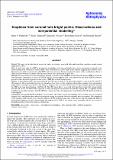Files in this item
Eruptions from coronal hole bright points : observations and non-potential modeling
Item metadata
| dc.contributor.author | Madjarska, Maria | |
| dc.contributor.author | Galsgaard, Klaus | |
| dc.contributor.author | Mackay, Duncan Hendry | |
| dc.contributor.author | Koleva, Kostadinka | |
| dc.contributor.author | Dechev, Momchil | |
| dc.date.accessioned | 2020-09-14T12:30:02Z | |
| dc.date.available | 2020-09-14T12:30:02Z | |
| dc.date.issued | 2020-11 | |
| dc.identifier | 267666027 | |
| dc.identifier | 03add8c4-bd44-4262-b3bb-a27ebb7692c1 | |
| dc.identifier | 85095112073 | |
| dc.identifier | 000588070500019 | |
| dc.identifier.citation | Madjarska , M , Galsgaard , K , Mackay , D H , Koleva , K & Dechev , M 2020 , ' Eruptions from coronal hole bright points : observations and non-potential modeling ' , Astronomy & Astrophysics , vol. 643 , A19 . https://doi.org/10.1051/0004-6361/202038287 | en |
| dc.identifier.issn | 0004-6361 | |
| dc.identifier.other | ORCID: /0000-0001-6065-8531/work/82788590 | |
| dc.identifier.uri | https://hdl.handle.net/10023/20619 | |
| dc.description | Funding: DHM would like to thank the Science and Technology Facilities Council (UK) through the consolidated grant ST/N000609/1 and the European Research Council (ERC) under the European Union Horizon 2020 research and innovation program (grant agreement No. 647214). | en |
| dc.description.abstract | Context. We report on the third part of a series of studies on eruptions associated with small-scale loop complexes named coronal bright points (CBPs). Aims. A single case study of a CBP in an equatorial coronal hole with an exceptionally large size is investigated to extend our understanding of the formation of mini-filaments (MFs), their destabilisation and the origin of the eruption triggering the formation of jet-like features recorded in the extreme-ultraviolet (EUV) and X-ray emission. We aim to explore the nature of the so called micro-flares in CBPs associated with jets in coronal holes and mini coronal mass ejections in the quiet Sun. Methods. Co-observations from the Atmospheric Imaging Assembly (AIA) and Helioseismic Magnetic Imager (HMI) on board the Solar Dynamics Observatory (SDO), and GONG Halpha images are used together with a Non-Linear Force Free Field (NLFFF) relaxation approach, where the latter is based on a time series of HMI line-of-sight magnetograms. Results. A mini-filament (MF) that formed beneath the CBP arcade around 3–4 h before the eruption is seen in the Halpha and EUV AIA images to lift up and erupt triggering the formation of an X-ray jet. No significant photospheric magnetic flux concentration displacement (convergence) is observed and neither is magnetic flux cancellation between the two main magnetic polarities forming the CBP in the time period leading to the MF liftoff. The CBP micro-flare is associated with three flare kernels that formed shortly after the MF liftoff. No observational signature is found for reconnection beneath the erupting MF. The applied NLFFF modeling successfully reproduces both the CBP loop complex as well as the magnetic flux rope that hosts the MF. Conclusions. The applied NLFFF modellng is able to clearly show that an initial potential field can be evolved into a non-potential magnetic field configuration that contains free magnetic energy in the region that observationally hosts the eruption. The comparison of the magnetic field structure shows that the magnetic NLFFF model contains many of the features that can explain the dfferent observational signatures found in the evolution and eruption of the CBP. In future it may eventually indicate the location of destabilisation that results in the eruptions of flux ropes. | |
| dc.format.extent | 13 | |
| dc.format.extent | 18451213 | |
| dc.language.iso | eng | |
| dc.relation.ispartof | Astronomy & Astrophysics | en |
| dc.subject | Sun: chromosphere | en |
| dc.subject | Sun: corona | en |
| dc.subject | Sun: activity | en |
| dc.subject | Sun: filaments | en |
| dc.subject | Sun: magnetic fields | en |
| dc.subject | Methods: observational, theoretical | en |
| dc.subject | QB Astronomy | en |
| dc.subject | QC Physics | en |
| dc.subject | DAS | en |
| dc.subject.lcc | QB | en |
| dc.subject.lcc | QC | en |
| dc.title | Eruptions from coronal hole bright points : observations and non-potential modeling | en |
| dc.type | Journal article | en |
| dc.contributor.sponsor | Science & Technology Facilities Council | en |
| dc.contributor.sponsor | European Research Council | en |
| dc.contributor.institution | University of St Andrews. Applied Mathematics | en |
| dc.identifier.doi | https://doi.org/10.1051/0004-6361/202038287 | |
| dc.description.status | Peer reviewed | en |
| dc.identifier.grantnumber | ST/S000402/1 | en |
| dc.identifier.grantnumber | 810218 | en |
This item appears in the following Collection(s)
Items in the St Andrews Research Repository are protected by copyright, with all rights reserved, unless otherwise indicated.

